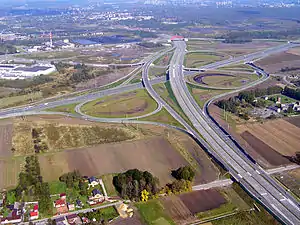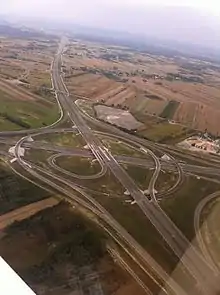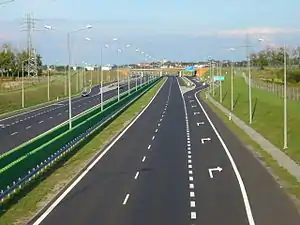Highways in Poland
Highways in Poland are public roads designed to carry large amounts of traffic.
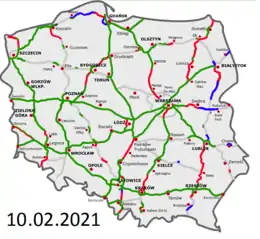
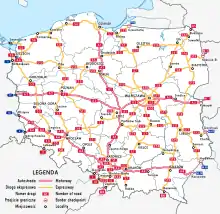
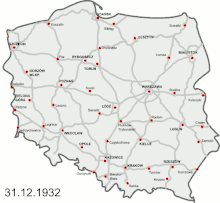
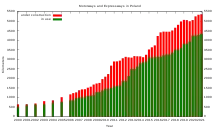
Limited-access highways are part of the national roads network and are divided into motorways and expressways. They feature two-level interchanges with other roads, emergency lanes, feeder lanes, wildlife protection measures and dedicated roadside rest areas. Motorways differ from expressways in technical parameters, like designated speed, permitted road curvature or minimal distances between interchanges. Moreover, expressways might have single carriageway sections in case of low traffic densities (as of 2020, only 5% of the highways are single-lane expressways).
Except for the single-carriageway expressways, both types of highways generally fulfill the definition of a motorway as characterized by OECD, WRA or Vienna Convention. Speed limits in Poland are 140 km/h on motorways and 120 km/h on dual-carriageway expressways.
As of August 2020, there are 4,203 km (2,612 mi),[1] of motorways and expressways in operation (51% of the intended network), while contracts for construction of further 1,218 km (757 mi),[2] of motorways and expressways (15% of the intended network) are ongoing.
.jpg.webp)


Technical parameters
 Motorways are public roads with limited access which are designated for motor vehicles only, and feature two carriageways with at least two continuous lanes each, divided by a median. They have no one-level intersections with any roads or other forms of land and water transport. They are equipped with roadside rest areas, which are intended only for the users of the motorway.
Motorways are public roads with limited access which are designated for motor vehicles only, and feature two carriageways with at least two continuous lanes each, divided by a median. They have no one-level intersections with any roads or other forms of land and water transport. They are equipped with roadside rest areas, which are intended only for the users of the motorway.
Some motorway stretches are tolled, others are free of charge. Motorways are the only roads in Poland which use blue background on road signs - others use green road signs.
 Expressways share most of the characteristics of motorways, differing mainly in that:
Expressways share most of the characteristics of motorways, differing mainly in that:
- Expressways are designated for lower speed than motorways. For example, the road curvature can be higher and the lanes are usually narrower (3.5 m vs 3.75 m). Emergency lanes can also be narrower, and in exceptional situations expressways might not have them at all.
- Expressways can have a single carriageway on sections with low traffic density.
- Motorways can have interchanges only with main roads and the spacing between interchanges should not be less than 15 km (exceptionally 5 km); or not less than 5 km (exceptionally 3 km) within borders or near a big city or a group of cities. Expressways can have interchanges more often. In exceptional situations, expressways might not have dedicated feeder lanes on an interchange.
Expressways are also technically allowed to admit a one-level junction with a minor public road in exceptional cases. However, reconstruction of the last such remaining junction in Poland was launched in 2019 and in June 2020 a two-level interchange was opened in its place.[3][4][5] The definitions and technical parameters of highways are defined in the Public Roads Act of 21 March 1985 (with later amendments),[6] and the ministry ordinance of 2 March 1999 (with later amendments).[7]
As of 2020, the motorways constitute about 40% of the length of existing highways, the dual carriageway expressways – about 55% and the single carriageway expressways – about 5%.
Speed limits
| Maximum speed (km/h) | |||
|---|---|---|---|
| Vehicle | |||
|
140 | 120 | 100 |
|
100 | ||
|
80 | ||
|
60 | ||
|
40 | ||
| Not allowed on motorways: pedestrians, bikes, mopeds, agricultural vehicles. Minimal speed on motorways is 40 km/h unless there are any extraordinary circumstances (e.g., snow, ice, or a car broken down). It is forbidden to stop except extraordinary situations, or travel backwards. Towing is not allowed on motorways, but is permitted on expressways. Roads are protected from animals crossing the road. | |||
Substandard highways
Motorways and expressways constructed before 1999 do not have to fulfill technical parameters listed in the ordinance. There are four notable cases of substandard highways in Poland:
- A4 on the section Krzyżowa – Wrocław (103 km (64 mi)) was constructed in years 1934 – 1937 (then the territory of Nazi Germany) and renovated in years 2002 – 2006. The road received new high quality surface but the geometry was kept unchanged and many overpasses above the motorway were kept. In effect, this part has no emergency lanes (which by current standards is only occasionally allowed on expressways and never on motorways) and speed limit is decreased to 110 km/h. A contract for preparing technical documentation for the section's full reconstruction (and widening to three lanes per direction) was signed in 2019.[8]
- A6 near Szczecin was constructed by Nazi Germany and while most of it was reconstructed in years 1996 – 1999, its easternmost section (5 km (3.11 mi)) still kept using the original surface from the 1930s until a reconstruction in years 2017 – 2020. As of June 2020, the last short fragment of about 800 m (875 yd) of the pre-WWII surface remains.[9][10]
- A18 (70 km (43 mi)) had its southern carriageway constructed by Nazi Germany. A high quality northern carriageway was constructed in 2004 – 2006, but southern carriageway still has the original surface made of concrete slabs. Due to very low quality of this carriageway, the route is marked as national road 18 and will only receive a status of A18 after reconstruction scheduled for years 2020 – 2023.[11]
- S3 near Szczecin (19 km (12 mi)) was opened in 1979 and has kept its expressway status despite having two at-grade road intersections. They have been reconstructed to interchanges by June 2020, which marks the moment when no more expressways with at-grade intersections have been left in Poland.[3][5]
Tolls
All expressways are free of payment for vehicles up to 3.5 tons, as are secondary motorways A6, A8 and A18.
Primary motorways A1, A2 and A4 are planned as tolled (some parts are already such). There are two systems of collecting tolls:
Open system
In this system money is only paid at the toll booths put across the road. Different payment is due according to the type of the vehicle. It is relatively cheap to operate, but it forces drivers to stop at each toll booth, thus lowering the capacity of a motorway. For example, the Greater Poland part of A2 has all of its toll booths spaced approx. 50 km apart.
Closed system
In this system, there are toll stations on every interchange both entering and exiting the motorway, as well as toll booths on the motorway at the ends of the tolled section. In this case the driver receives a ticket upon entering the motorway and pays at either toll station while exiting the motorway or at the toll booth at the end of the tolled section, with the price dependent on the distance driven. This system is more expensive at building and maintenance, but allows much larger distances between toll booths across the motorway.
Tolled sections
The following list of tolled sections is valid as of January 2020, and only applies to vehicles up to 3.5 tons. The prices listed apply to passenger cars driving the section's whole length.
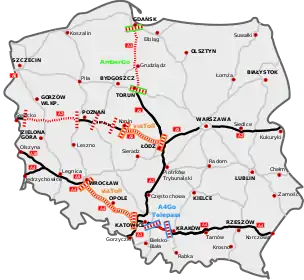

- Motorway A1:
- Tolled: 152 km (94.45 mi) Gdańsk – Toruń (managed by Gdańsk Transport Company, closed system, 30 PLN ($8))
- Free: 197 km (122.41 mi) Toruń – Piotrków Trybunalski
- Under construction: 81 km (50.33 mi) Piotrków Trybunalski – Częstochowa
- Free: 134 km (83.26 mi) Częstochowa – Gorzyczki
- Motorway A1:
- Motorway A2:
- Tolled: 133 km (82.64 mi) Rzepin – Poznań (managed by Autostrada Eksploatacja S.A., closed system, 38 PLN ($10))
- Free: 26 km (16.16 mi) Poznań bypass
- Tolled: 85 km (52.82 mi) Poznań – Sługocin (managed by Autostrada Eksploatacja S.A., open system, 40 PLN ($10))
- Free: 19 km (11.81 mi) Sługocin – Konin as so-called "buffer zone" between two different systems
- Tolled: 103 km (64.00 mi) Konin – Stryków (Łódź) (managed by the state, closed system, 10 PLN ($3))
- Free: 94 km (58.41 mi) Stryków (Łódź) – Warsaw
- Free: 36 km (22.37 mi) Warsaw – Mińsk Mazowiecki
- Planned: 135 km (83.89 mi) Mińsk Mazowiecki – Kukuryki
- Motorway A2:
- Motorway A4:
- Free: 153 km (95.07 mi) Zgorzelec – Bielany Wrocławskie,
- Tolled: 163 km (101.28 mi) Bielany Wrocławskie – Gliwice-Sośnica (managed by the state, closed system, 16 PLN ($4))
- Free: 34 km (21.13 mi) Gliwice-Sośnica – Mysłowice,
- Tolled: 52 km (32.31 mi) Mysłowice – Kraków-Balice (managed by Stalexport Autostrada Malopolska S.A., open system, 20 PLN ($5))
- Free: 268 km (166.53 mi) Kraków-Balice – Korczowa
- Motorway A4:
viaTOLL payment system

From 1.07.2011 all vehicles weighing more than 3.5 tons are obliged to have a special viaTOLL apparatus. On the chosen roads (some motorways, expressways and national roads) the special electronic readers are installed. They connect to the apparatus in the vehicle in a wireless way, and they also count the toll the vehicle has to pay. It is possible to buy it on some petrol stations or at the special points of selling. If the apparatus isn't at the place, fines are applied:
- 1500 PLN if the car is heavier than 12 tons
- 750 PLN if the car is heavier than 3.5 tons but lighter than 12 tons.
Planned Electronical Toll Collection System
In 2014 the Ministry of Infrastructure and Development has uncovered the plans to imply the Electronical Toll Collection System. The new plans were made because of the big problems concerning the Manual Toll Collection System. At the time while there is a huge flow of traffic (especially in the holiday period), there are long queues to the toll booths, which, according to some reports, reached up to 10 km. Drivers in these cases are forced to wait 2 hours to pay the toll at the toll booths. That was the reason the works to construct the toll booths on A4 were suspended, even though there were some stages of construction in progress.
The situation wasn't much relieved even after the toll booths had separated a special lane for those vehicles that have been registered into the ViaAuto system. It came out even worse. A lot of experts tell it is one lane less for those paying traditionally.
At those times a few simple solutions were introduced, for example the cashiers themselves giving the tickets. Next solution came from the Council of Ministers, which claimed that the motorway will be free from the day they gave out the decision (06.08.2014) to the end of the summer holidays (it only concerned the period from 4.00 p.m. on Friday to midnight from Sunday to Monday).
Now the ministry is working on a new electronic system. According to different concepts, there are two options - either the full liquidation of the toll booths or their reconstruction. The reconstructed toll booths had then the toll applied via the viaTOLL system, so every vehicle must have had the viaTOLL apparatus, as the cars and trucks heavier than 3.5 tons have. Taking into account that not every driver drives regularly on the motorway, there must have been an online registration for light cars introduced. After that, when any car would arrive to such a toll booth, the registration plate will be scanned in order to recognise the car. The implication, however, will become true after signing of agreements with private concessionaires first.
List of Polish motorways and expressways with progress of construction
In May 2004, the Council of Ministers of Poland published a document including the planned highway network, the length of which was about 7,200 km (4,474 mi) and contained most of the highways in plans today.[12] More notable among the changes introduced in later amendments include re-routing S8 and adding S61 instead (2009, a change related to the Rospuda Valley conflict),[13] introducing S16 (2015, 2016), S52 (2016) and A50/S50 (2019),[14] as well as extending S5 to Ostróda (2015) and to Bolków (2019), S10 to Wołomin (2015) and S8 to Kłodzko (2019).[15][14] The planned network consists of 16 major highways (over 200 km of total intended length): A1, S3, S5, S7, S11, S17, S19 and S61 running north to south, and A2, A4, S6, S8, S10, S12, S16 and S74 running west to east. 4 shorter motorways and 9 expressways complete the planned network.
The following table summarizes the progress of construction of the motorway and expressway network:[lower-alpha 1][lower-alpha 2] [18][19][20][21]
1) Highways and major sections completed | |||||||||||
|---|---|---|---|---|---|---|---|---|---|---|---|
| Sign | Route | Location | Total length | Existing | Years of construction | ||||||
western section |
 |
454.9 km[lower-alpha 3] | 454.9 km | 100% | 2001 – 2012 and 48 km in 1977 – 1988 | ||||||
 |
670 km | 670 km (of these, 103 km substandard: no emergency lanes) |
100% | 1976 – 2016 | |||||||
western section |
Poznań (A2/S11) - Leszno - Wrocław (A8) | 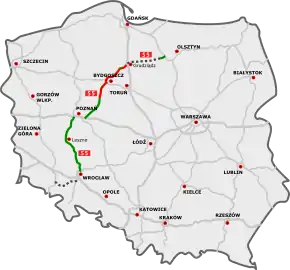 |
156.5 km[lower-alpha 4] | 156.5 km | 100% | 2014 – 2019 | |||||
main section |
Wrocław (A4) - Łódź (A1) - Piotrków Trybunalski - Warsaw (A2/S7/S17) - Ostrów Maz. (S61) - Białystok (S19) |  |
556.3 km[lower-alpha 5] | 100% | 2008 – 2019 [lower-alpha 6] | ||||||
| Elbląg – |
48.6 km | 48.6 km 1 carriageway |
50% | 2006 – 2008 [lower-alpha 7] | |||||||
| Olsztyn (S16) – Olsztynek (S7) | 35.1 km | 35.1 km | 100% | 2009 – 2019 | |||||||
| Warsaw – airport – S2 | Warsaw | 4.8 km | 4.8 km | 100% | 2009 – 2013 | ||||||
| Katowice – Sosnowiec | Upper Silesia | 5.9 km | 5.9 km | 100% | 1978 – 1985 | ||||||
2) Highways in development | |||||||||||
| Sign | Route | Location | Total length | Existing | In realisation[lower-alpha 8] | Of which under active construction | Scheduled date(s) of opening | Tender | In predesign[lower-alpha 9] | ||
| Gdańsk (S6) - Grudziądz (S5) - Toruń (S10) - Łódź (A2/S8) - Gliwice (A4) - |
 |
566.6 km | 485.9 km | 85.8% | 64.8 km reconstruction of a dual carriageway highway from the 1970s to motorway standard + 15.9 km reconstruction of a substandard motorway from the 1980s |
2021, 2022 | |||||
| Szczecin (southern bypass) |
29 km | 28.2 km + 0.8 km substandard: the original 1930s' surface |
97.2% (100%) |
2021? | 0.8 km (reconstruction) |
||||||
 |
76.5 km | 7 km + 34 km northern carriageway[lower-alpha 10] + 35.5 km 1st carriageway[lower-alpha 11] |
54.8% | reconstruction of the carriageway with the original 1930s' surface: | |||||||
| 33.6 km southern carriageway |
2022, 2023? | 35.9 km southern carriageway | |||||||||
| Pyrzowice (A1) - Mysłowice (A4) - Bielsko-Biała (S52) - Zwardoń - |
 |
144 km | 62.3 km + 26.7 km 1st carriageway |
52.5% (61.8%) |
4.8 km + 3.7 km 1st carriageway + 9.7 km 2nd carriageway |
2021, 2023 | |||||
| (+ 44 km) non‑expressway dual carriageway |
(94.1%) | + 7 km (reconstruction) + 27.2 km (new route) |
2023, 2024? | 12.3 km (new route) |
|||||||
| Świnoujście - Szczecin (A6) - Gorzów Wielkopolski - Jordanowo (A2) - Zielona Góra - Lubin - Legnica (A4) - |
 |
454.9 km | 352.2 km + 5.4 km 1st carriageway |
78% | 97.3 km + 5.4 km 2nd carriageway |
36.8 km | 2021 Szczecin – Legnica 2022, 2023 to Czech Republic 2021, 2024 to Świnoujście |
||||
middle section |
Grudziądz (A1) - Bydgoszcz (S10) - Gniezno - Poznań (A2/S11) |  |
181.8 km[lower-alpha 4] | 88.1 km + 12.8 km 1st carriageway |
52% | 80.9 km + 12.8 km 2nd carriageway |
2020, 2021, 2022 |
||||
| Gdańsk (A1)[lower-alpha 12] - Elbląg (S22) - Olsztynek (S51) - Warsaw (A2/S8) - Radom (S12) - Kielce (S74) - Kraków (A4) - Rabka-Zdrój |  |
ca. 674 km | 424.3 km + 7.6 km 1st carriageway |
63.5% | 124.5 km + 7.6 km 2nd carriageway |
2021, 2022, 2023, 2024? |
5.3 km | ||||
| (+ 112 km) non‑expressway dual carriageway |
(80.1%) | + 39.6 km (reconstruction) + 24.3 km (new route) |
+ 5 km (reconstruction) + 24.3 km (new route) |
2021, 2022, 2023, 2025, 2026? |
22.1 km (reconstruction + new route) | ||||||
| N/A | + ca. 25 km Preliminary works (reconstruction or new route) | ||||||||||
| S8 - Pabianice - Zgierz - A2 | Łódź (western bypass) |
41.4 km | 12.9 km | 31.2% | 28.5 km | 2021, 2023 | |||||
middle section |
Warsaw (A2) – Lublin (S12/S19) |  |
150.2 km[lower-alpha 13] | 148.3 km | 98.7% | 1.9 km |
2020 | ||||
middle section |
Lublin (S12/S17) - Stalowa Wola - Rzeszów (A4) (part of Via Carpathia) |
 |
158 km[lower-alpha 14] | 12.9 km + 16.3 km 1st carriageway[lower-alpha 15] |
13.3% | 128.8 km | 2021, 2022 | 16.3 km 2nd carriageway | |||
part 2 |
Kraków-Balice (A4) – Kraków‑Mistrzejowice (S7) | Kraków (northern bypass) |
18.3 km | 5.8 km | 31.4% | 12.5 km | 2023 | ||||
| Ostrów Mazowiecka (S8) - Łomża - Ełk (S16) - Suwałki - (Via Baltica) |
 |
211.8 km | 32.8 km + 5.3 km 1st carriageway |
16.4% | 173.7 km + 5.3 km 2nd carriageway |
121.8 km + 5.3 km 2nd carriageway |
2021, 2022, 2023 | ||||
3) Highways partially in development | |||||||||||
|---|---|---|---|---|---|---|---|---|---|---|---|
| Sign | Route | Location | Total length | Existing | In realisation | Of which under active construction | Tender | Predesign complete | In predesign[lower-alpha 9] / In design [lower-alpha 16] |
Planned completion [22][19][23] | |
eastern section |
Warsaw (S7/S8) - |
 |
202 km | 24.1% | 75.9 km | 32.6 km | S2: 2021 A2: 2025 | ||||
| Szczecin (A6) - Goleniów (S3) - Koszalin (S11) - Słupsk - Gdańsk (A1)[lower-alpha 12] |  |
432.6 km | 181.9 km + 9.4 km 1st carriageway |
43.1% | 40.9 km | 95.8 km + 9.4 km 2nd c/w |
45.4 km | 2025 [lower-alpha 17] | |||
| + 59.2 km | |||||||||||
| Koszalin (S6) - Piła (S10) - Poznań (A2/S5) - Ostrów Wielkopolski - Kępno (S8) - Tarnowskie Góry - A1 |  |
ca. 565 km | 79.7 km + 8.6 km 1st carriageway |
14.8% | 75.7 km + 3.6 km 1st carriageway |
3.2 km + 3.6 km 1st carriageway |
21.7 km | 2028 | |||
| + 44.6 km | |||||||||||
| + ca. 331 km + 12.2 km 2nd c/w | |||||||||||
4) Planned highways | |||||||||||
|---|---|---|---|---|---|---|---|---|---|---|---|
| Sign | Route | Total length | Existing | In realisation | Of which under active construction | Tender | Predesign complete | In predesign[lower-alpha 9] | Preliminary works[lower-alpha 18] | Planned completion [22][23][19] | |
| Eastern extension[lower-alpha 19]: Ostróda (S7) – Grudziądz (A1) |
ca. 104.3 km | 8.7 km | 8.4% | 5.6 km | ca. 90 km | Not before 2029 | |||||
| Western extension[lower-alpha 20]: Bolków (S3) – Świdnica – S8 |
ca. 55 km | 0 km | 0% | ca. 55 km | Not before 2029 | ||||||
| Southern extension[lower-alpha 20]: Kłodzko – Wrocław (A8) |
ca. 82.4 km | 5.1 km | 6.2% | ca. 77.3 km | 2027 | ||||||
| Szczecin (A6) - Piła (S11) - Bydgoszcz (S5) - Toruń (A1) - Płock - Płońsk / Nowy Dwór Mazowiecki (S7) | ca. 440.5 km | 29.6 km + 24.6 km 1st carriageway |
9.5% | 17.8 km + 6.4 km 2nd carriageway |
40 km + 11.6 km 2nd c/w |
ca. 140 km | Not before 2028 | ||||
| + 108 km | |||||||||||
| + ca. 80.5 km + 6.6 km 2nd c/w | |||||||||||
| Piotrków Trybunalski (A1) - Sulejów (S74) - Radom (S7) - Puławy west of Lublin (S17) | ca. 185 km | 16.4 km + 6.3 km 1st carriageway |
10.7% | 103.8 km | 2029 | ||||||
| + ca. 58.5 km + 6.3 km 2nd c/w | |||||||||||
| Piaski east of Lublin (S17) - Chełm - |
75.6 km | 1.1 km | 1.5% | 14 km | 60.5 km | 2025 | |||||
| Olsztyn (S51) - Ełk (S61) - Białystok (S19) | ca. 223 km | 20.4 km + 18.5 km 1st carriageway |
13.3% | 16.5 km | 11.1 km + 18.5 km 2nd c/w |
ca. 156.5 km | Not before 2027 | ||||
| Warsaw eastern bypass | 17.3 km | 0 km | 0% | 3.5 km | 3.6 km | 10.2 km | 2027 | ||||
| Eastern section: Lublin (S12/S19) - Zamość - |
155 km | 29 km + 2 km 1st carriageway |
19.4% | 9.6 km | 92 km | 2026 | |||||
| + 22.4 km | |||||||||||
Via Carpathia |
Northern section: |
ca. 327 km | 14.5 km 1st carriageway |
2.2% | 158.1 km | 87.7 km + 14.5 km 2nd c/w |
2026 | ||||
| + ca. 66.7 km | |||||||||||
| Southern section: Rzeszów (A4) - |
96.6 km | 11.4 km | 11.8% | 10.2 km | 18.4 km | 56.6 km | 2029 | ||||
| CPK (A2) – Mińsk Maz. (A2) – CPK (A2) (Warsaw 2nd ring) |
ca. |
0 km | 0% | ca. 240 km | Not before 2029 | ||||||
| 98 km | 37 km | 37.8% | 61 km | 2031 | |||||||
| Sulejów (S12) - Kielce (S7) - Sandomierz - Nisko (S19) | ca. 206.6 km | 6.2 km | 3% | 124.4 km | 2029 | ||||||
| + ca. 76 km | |||||||||||
|
In total | ||||||||||
|---|---|---|---|---|---|---|---|---|---|---|
| Highway type | Planned length | Existing | In realisation[lower-alpha 8] | Of which under active construction | Tender | Predesign complete | In predesign | Preliminary works | No progress | |
| Motorways as of 1 July 2020 |
ca. 2,086.9 km (1,296.7 mi) | 1,684.2 km (1,046.5 mi) + 69.5 km 1st carriageway |
82.37% | 123.9 km (77.0 mi) + 33.6 km 2nd carriageway |
100.1 km (62.2 mi) + 33.6 km 2nd carriageway |
76.7 km (47.66 mi) + 35.9 km 2nd carriageway |
32.6 km (20.3 mi) | 100 km (62 mi) | ||
| Expressways as of 1 July 2020 |
ca. 6,057.7 km (3,764.1 mi) | 2,296.6 km (1,427.0 mi) + 214.6 km 1st carriageway |
39.68% | 871.3 km (541.401 mi) + 16.9 km 1st c/w + 49.8 km 2nd c/w |
601.9 km (374.0 mi) + 16.9 km 1st c/w + 49.8 km 2nd c/w |
281 km (174.6 mi) + 14.8 km 2nd carriageway |
33.1 km (20.6 mi) + 18.5 km 2nd carriageway |
1,895.5 km (1,177.8 mi) + 77.1 km 2nd carriageway |
450 km (280 mi) | 71.3 km 2nd carriageway[lower-alpha 21] |
| Total | ca. 8,144.5 km (5,060.8 mi) | 3,980.8 km (2,473.6 mi) + 284.1 km 1st carriageway |
50.62% | 995.2 km (618.4 mi) + 100.3 km 1 carriageway |
701.2 km (435.7 mi) + 100.3 km 1 carriageway |
357.7 km (222.3 mi) + 50.7 km 2nd carriageway |
33.1 km (20.6 mi) + 18.5 km 2nd carriageway |
1,928.1 km (1,198.1 mi) + 77.1 km 2nd carriageway |
550 km (342 mi) | 71.3 km 2nd carriageway |
- Major changes in the network (e.g. opening of long fragments of a road, signing the last contract of a given section) are accounted continuously, while a general update including all the details is done every several months (last: July 1st, 2020). 'In total' length statistic is kept consistent as of the last general update, and might hence not be the exact sum of the current state of the table.
- Some highways can overlap. The table shows data without overlapping sections such that each fragment is counted exactly once, in accordance with how they are attributed in the ministry ordinance,[16] i.e. each common section is attributed to the road with the lower number (in case of two expressways overlapping) or to a motorway (in case of a motorway and an expressway overlapping), except for S12/S17 near Lublin which is signed as S17[17].
- Aggregate length for A2: 622.1 km (Completed: 76.2%, in realisation: 6.3%)
- Aggregate length for S5 including Ostróda and Bolków extensions (added to the plans in 2015/2019): 493.1 km (Completed: 52%, in realisation: 17.4%)
- Aggregate length for S8 including Kłodzko extension (added to plans in 2019): 616 km (Completed: 87.5%)
- Short fragments (several bypasses of towns) constructed earlier.
- In place of a largely destroyed Nazi German motorway from the 1930s.
- Sections under active construction and sections under a joint Design & Build contract.
-
In the late predesign phase, i.e. after having obtained environmental decision (0–2 years to finish).In the process of obtaining environmental decision.In the early predesign stage (Polish: STEŚ).
- Open in a 2×2 profile: the west-bound traffic is carried by the new motorway carriageway, while the east-bound traffic is carried by the low quality pre-WWII carriageway. Section not signed as a motorway.
- Bidirectional traffic is carried by the new high quality carriageway (one lane per direction), while the old carriageway is closed for reconstruction. Section not signed as a motorway.
- According to the ordinance, a fragment of S6 (1st Tricity bypass) is ultimately to become a section of S7 after 2nd Tricity bypass (S6) is constructed. Until the actual relabelling takes place, this fragment is being accounted to S6 and not to S7 in the table.
- Aggregate length for S17: 322.5 km (Completed: 33.8%, in realisation: 13.2%)
- Aggregate length for S19: 581.6 km (Completed: 7.1%, in realisation: 22.1%)
- An interchanging 2+1 profile.
-
Design, if it is conducted as part of the predesign process rather than as part of a design-build contract.
- Except for Szczecin western bypass, which is planned in a public-private partnership with a precise schedule unknown.
- Analysis determining the optimal corridor for the planned highway (Polish: Studium Korytarzowe)
- Added to the plans in 2015
- Added to the plans in 2019
- Single carriageway expressways which are currently not planned for widening to dual carriageways: 48.6 km of S22, 20.7 km of S1, 2 km of S17
Annual average daily traffic on Polish highways
The latest general measurement of annual average daily traffic in Poland was conducted in 2015.
Traffic volumes in Poland note rapid increase since the fall of communism in 1989: the average volumes recorded in 2015 amount to 297% of the average volumes recorded in 1990.[24][25] With the increasing traffic, the length of overburdened regular national roads has also increased (the measurement analysis defines a regular single carriageway country road as overburdened if recorded average annual traffic exceeds 15'000 vehicles per day[25]). In 2015, 956 km of such national road sections, excluding sections within the borders of large cities, were observed (against 497 km in 2000). Due to large number of highway sections opened between 2010 and 2015, however, in the 2015 measurement this figure fell down compared to the preceding measurement for the first time in history.[25]
The following highways recorded highest and lowest traffic volumes in 2015:[26]
| No | Section | Vehicles / day | Notes |
|---|---|---|---|
| Most busy highways in Poland | |||
| 1 | S8 in Warsaw | 142k | S8 serves both the transit and local traffic, and long traffic jams form on it during rush hours. Section with 3 lanes per direction. The average traffic has risen to 201k in 2018.[27] |
| 2 | S86 | 112k | S86 serves mainly local traffic between Sosnowiec and Katowice and is not part of Poland's transit network. 3 lanes per direction. |
| 3 | A4 in Katowice | 101k | A4 serves both the transit traffic (2 lanes per direction) and local traffic (2 lanes per direction). |
| Least busy highways in Poland | |||
| 1 | S1 near |
1.0k – 2.4k | Single carriageway section, not intended for widening due to low traffic. Note: Until 2017, when the Svrčinovec - Skalité section of D3 on the Slovak side was completed, all heavy traffic was banned from using the border crossing, which additionally decreases the densities recorded in the measurement. |
| 2 | A4 from |
1.9k – 4.0k | |
| 3 | S22 (whole, i.e. from |
2.6k – 5.8k | Single carriageway expressway, not intended for widening due to low traffic. |
| 4 | bypasses (or parts thereof) of Słupsk (S6), Stargard (S10), Wyrzysk (S10), Kock (S19) and Międzyrzec Podlaski (S19) | 5.8k – 6.5k | Single carriageway bypasses constructed with allocated space for widening in the future, Stargard bypass constructed as dual carriageway. |
The following single carriageway national roads recorded highest traffic volumes in 2015:[26]
| No | Section | Vehicles / day | Notes |
|---|---|---|---|
| Most busy single carriageway national roads in Poland | |||
| 1 | DK92 at the western entrance to Warsaw | 36k | |
| N/A | DK5 south of Poznań | 30k | In 2019, S5 was opened on this section. |
| N/A | DK4 east of Rzeszów | 28k | In 2016, A4 was opened on this section. |
| N/A | DK91 between Łódź and Zgierz | 28k | In 2016, A1 (Łódź eastern bypass) was opened. S14 (Łódź western bypass) is under construction. |
| 2 | DK44 in Oświęcim | 26k | Oświęcim bypass is in realization (design-build). |
| 3 | DK5 north of Bydgoszcz | 25k | S5 (Bydgoszcz bypass) is under construction. |
| 4 | DK19 north of Lublin | 25k | S19 is planned (under tender). |
Next general measurement was to be conducted throughout 2020, but had to be partially delayed due to COVID-19 pandemic.[29][30]
History
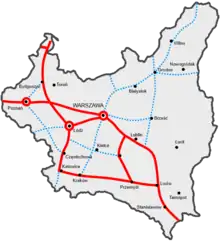
Before World War II
The first plans of creation of a national highway network in Poland were conceived in the interwar period:
The main promoter of this concept was Professor Melchior Wladyslaw Nestorowicz of the Warsaw University of Technology, who organized three Road Congresses, during which a group of specialists discussed the creation of the network. On March 5, 1939, in the trade magazine Drogowiec, Professor Nestorowicz proposed a very ambitious plan for the construction of almost 5,000 kilometres of category I and II roads, based on similar programmes in Germany and Italy.[31] Nestorowicz sketched a map of the future system with the following routes:
First class roads would, according to the plans, consist of the following motorways (totalling some 2,500 km (1,553.4 mi):
- Warsaw - Łódź - 100 km
- Warsaw – Poznań - Polish-German border - 350 km
- Warsaw beltway - 130 km
- Poznań beltway - 80 km
- Gdynia – Bydgoszcz – Łódź – 500 km
- Łódź beltway - 90 km
- Bytow - Free City of Danzig border - 50 km
- Katowice – Kraków – Lwów - 375 km
- Warsaw – Lublin - Lwów – Sniatyn - Polish-Romanian border - 550 km
- Puławy – Sandomierz – Przemyśl - 175 km
Second class roads would consist of the following motorways, totalling another 2,295 km (1,430 mi):
- Piotrków Trybunalski - Kielce - Sandomierz - 180 km
- Warsaw – Kielce – Kraków - 180 km
- Łódź - Kalisz - Polish-German border north of Wrocław - 130 km
- Warsaw – Grodno – Vilnius – Polish - Lithuania - Latvian border near Daugavpils - 575 km
- Grodno - Nowogrodek - Polish-Soviet border near Minsk - 190 km
- Bydgoszcz – Poznań – Częstochowa - 350 km
- Katowice – Cieszyn – Polish-Czechoslovak border - 60 km
- Ostrołęka - Polish-East Prussian border - 50 km
- Grodno - Polish-Lithuanian border - 40 km
- Grodno - Brzesc nad Bugiem - Krasnystaw - 300 km
- Warsaw – Brzesc nad Bugiem - 170 km
In 1934, Nazi Germany started the construction of their motorway system, parts of which today form A18 and A4 to Wrocław (Breslau), as well as A6 Szczecin bypass and S22 (parts of the planned motorway to Königsberg). About half of them were constructed as single-carriageway with the intention of adding a second carriageway in later years. However, after 1938, warfare expenses meant little money would be invested into any infrastructure and only one 9 km single-carriageway piece west of Gliwice (now A4) was constructed.
In Poland, a 28 km stretch between Warlubie and Osiek (now DW214) was constructed in 1937 – 1939 in the motorway standard of the time (today not considered a highway) with a concrete surface, which was designed by Italian engineer Piero Puricelli. The motorway was planned to reach Gdynia, but the outbreak of the Second World War halted the plans.
| Signage | Section | Length | Start of construction | Opening | Notes |
|---|---|---|---|---|---|
| Krzywa-Bielany Wrocławskie | 91 km (56.5 mi) | 1934 | 27 September 1936 | ||
| Krzyżowa-Krzywa | 12.3 km (7.6 mi) | 17 October 1937 | |||
| Bielany Wrocławskie-Brzeg(Owczary) | 34.1 km (21.2 mi) | 1938 | Southern carriageway only | ||
| Ujazd(Nogowczyce)-Łany | 9.1 km (5.7 mi) | 1940 | 1942 | ||
| Łany-Kleszczów | 8.8 km (5.5 mi) | 1936 | 1938 | ||
| 2.6 km (1.6 mi) | 1934 | 27 September 1936 | |||
| Szczecin-Zachód-Rzęśnica | 26.6 km (16.5 mi) | 1938 | |||
| Iłowa-Golnice | 32 km (19.9 mi) | 1935 | 17 October 1937 | Southern carriageway only | |
| 37.2 km (23.1 mi) | 1936 | 1938 | |||
| Golnice-Krzyżowa | 5.9 km (3.7 mi) | 1936 | 1938 | ||
| Elbląg-Grzechotki | 51.4 km (31.9 mi) | 1934 | 1938 | Western carriageway only | |
| Total | 316.9 km (196.9 mi) of which 178.5 km (110.9 mi) single carriageway |
Note: Signage of the roads at the time of opening was different. | |||
1945 – 1972
The Potsdam conference defined the borders for communist Poland, which were very different from the pre-1939 ones. It received the so-called Regained Territories from the former Third Reich with the aforementioned motorway sections (some of them with first carriageway only). Most of the motorway bridges were destroyed by the warfare, but only a few were repaired or rebuilt in the first post-war years. The bridge over Ina river was reconstructed in 1972, and those on S22 only between 1996 and 2003.
Apart from the bridges, almost all the motorways were left in the same condition as they were in 1945 until the mid-1990s. The only road left from Nazi times that was completed by the People's Republic of Poland was a one-carriageway small section between Łęczyca and Lisowo (15 km of what is now DW142), which was built on the previous works of Nazis.
At the post-war year there were very ambitious plans to make a motorway network for the whole Poland. For example, engineer Eugeniusz Buszma has published his propositions to the network in the magazine "Drogowiec" (1946, issue 1):
- East – West (Słubice – Warsaw – Białystok) – 680 km
- North – South (Gdynia – Warsaw – Balkans) – 650 km
- Silesia – Baltic I (Gdańsk – Łódź – Katowice) – 460 km
- Pomeranian (Gdańsk – Szczecin) – 280 km
- Silesian (Wrocław – Katowice – Kraków) – 190 km
- Mazurian (Kaliningrad – Elbląg – Malbork) – 20 km
- Silesia – Baltic II (Bydgoszcz – Wrocław) – 260 km
- Łódź – Wrocław – (Prague) – 310 km
- Katowice – (Vienna) – 60 km
- Poznań – Szczecin – 200 km
- Radom – Lublin – (Lviv) – 220 km
In total, the mileage, according to the proposal, would total more than 3,300 km (2,050 mi).
After the addition of the sections built by the Third Reich the total network length had to be ca. 3700 km. In 1963 the Motorization Council at the Council of Ministers had presented the similar plan plus the motorways: Warsaw-Kraków-Zakopane, Kraków-Przemyśl, Warsaw-Bydgoszcz-Koszalin, Poznań-Koszalin i Warsaw-Terespol (ca. 1250 km). None of those plans were realized, however.
Despite announcing such pompous plans, no motorway was opened in the meantime.
In the 1970s

Only in the 1970s did any works start. In 1972 it was planned to build:
- the Gliwice-Kraków motorway (now A4)
- the second carriageway of the Wrocław-Gliwice motorway (also A4)
- the Warsaw-Katowice motorway (so-called "Gierkówka", now the S8/A1 road), in the near future
The plans were expanded in 1976 by the following sections:
- Tarnów – Kraków (now A4),
- eastern GOP (Górnośląski Okręg Przemysłowy) bypass (now S1, northern part),
- Bielsko-Biała – Cieszyn (now S1, southern part),
- Warszawa – Poznań (so-called Olimpijka, now A2),
- Łódź – Piotrków Trybunalski (now A1).
In 1973 – 1976, "Gierkówka" dual carriageway from Warsaw to Katowice (281 km (175 mi)) was built. Originally planned as a motorway, it was in the end constructed by adding another carriageway to the existing road, hence going through many villages and crossing with local roads. However, the part from Piotrków Trybunalski to Częstochowa (78 km (48 mi)) was constructed on a new route in a semi-motorway standard: the road was constructed on a motorway alignment but majority of the intersections between the highway and the other roads were constructed as one-level with no viaducts or overpasses.
| Signage | Section | Length | Start of construction | Opening |
|---|---|---|---|---|
| Piotrków Trybunalski – Częstochowa semi-motorway standard (one-level intersections) |
78 km (48 mi) | 1973 | 1976 | |
| Tri-city bypass (eastern carriageway) substandard (two one-level intersections, then reconstructed when adding a second carriageway in 1980s) |
37.7 km (23.4 mi) | 1973 | 1977 | |
| Rzęśnica – Goleniów substandard (one-level intersections) |
19.3 km (12.0 mi) | 1976 | 1979 | |
| Total | 57 km (35.4 mi) of which 37.7 km (23.4 mi) single carriageway | |||
In the 1980s
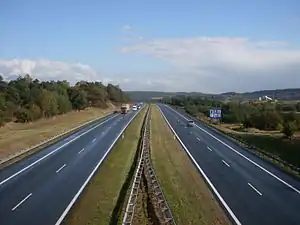
Near the end of 1970s the first construction of motorways started and continued to the next decade. The roads opened in the 1980s were the first motorways and expressways which generally meet the contemporary standards, at least with respect to their more important attributes.
In 1985 the government already planned to build the expressways apart from the motorways. The major routes planned as motorways were A1, A2 and A4. The realization of these plans however came at a very slow pace: throughout the 1980s, only an average of 20 km (12 mi) of highways in the whole country were being opened per year.
| Highway sections opened in the 1980s average: 20.5 km / year | |||||
|---|---|---|---|---|---|
| Signage | Section | Length | Start of construction | Opening | Notes |
| Tuszyn-Piotrków Trybunalski | 16.1 km (10.0 mi) | 1978 | 18 December 1989 | Section under reconstruction 2019 – 2021 | |
| Września-Sługocin (Golina) | 35.7 km (22.2 mi) | 1977 | 9 October 1985 | ||
| Sługocin - Konin West | 13.5 km (8.4 mi) | 1986 | 10 November 1988 | ||
| Chrzanów - Kraków (Balice I) | 29.6 km (18.4 mi) | 1976 | 3 January 1983 | ||
| Jaworzno - Chrzanów | 6.1 km (3.8 mi) | 1978 | 22 November 1986 | ||
| Kraków bypass (section Balice I - Tyniec) | 7.8 km (4.8 mi) | 1979 | 8 December 1988 | ||
| Dąbrowa Górnicza - Tychy | 34.7 km (21.6 mi) | 1978 | 1983 | ||
| Tri-city bypass (to Straszyn) | 32.4 km (20.1 mi) | 1978 | 1984 | Second carriageway | |
| Kielce bypass | 22.9 km (14.2 mi) | 1974 | 1984 | First carriageway | |
| Katowice - Sosnowiec | 6.8 km (4.2 mi) | 1978 | 1985 | First completely done expressway | |
| Total | 205.6 km (127.8 mi) of which 55.3 km (34.4 mi) single carriageway | ||||
In the 1990s
In the III Republic of Poland the plans started to change again. Planned S3 was promoted to a motorway standard as A3 (the decision was later reversed) and a plan was introduced (also later reversed) of constructing the highway Łódź – Wrocław – Bolków in a motorway standard as A8. Szczecin bypass (A6) and Olszyna – Krzywa (then named A12, now A4/A18) were promoted to motorways, even though at that time majority of their lengths was in bad shape, laid with the original concrete surface from the 1930s with no significant works having been performed on any of them throughout the communist period.
| Highway sections opened in the 1990s average: 15 km / year | |||||
|---|---|---|---|---|---|
| Signage | Section | Length | Start of construction | Opening | Notes |
| Mysłowice - Jaworzno | 15.9 km (9.9 mi) | 1986 | 29 November 1990 | Northern carriageway only | |
| 4 September 1991 | Southern carriageway only | ||||
| Kraków bypass (section Tyniec - Skawina) | 3.5 km (2.2 mi) | 1988 | 1993 | ||
| Kraków bypass (section Skawina - ul.Kąpielowa) | 5.4 km (3.4 mi) | 1993 | 27 October 1995 | A4 had a crossroad with ul. Kąpielowa till 2002, when the bridge was built over it. | |
| Jędrzychowice |
1.8 km (1.1 mi) | 1992 | 15 July 1994 | ||
| Katowice Francuska - Mysłowice | 11.1 km (6.9 mi) | 1989 | 30 October 1996 | ||
| Katowice Mikołowska - Katowice Francuska | 1.9 km (1.2 mi) | ? | 10 November 1999 | ||
| Krzyżowa - Krzywa | 10.2 km (6.3 mi) | 1995 | Renovated | ||
| 12.7 km (7.9 mi) | 1996 | 1999 | Renovated | ||
| Olszyna |
9.6 km (6.0 mi) | ? | 1993 | Northern carriageway added (+ 350 m (383 yd) renovated southern carriageway at the border) | |
| Golnice - Krzyżowa | 5.9 km (3.7 mi) | 1995 | Renovated both carriageways | ||
| Cieszyn |
5.2 km (3.2 mi) | 1991 | 1995 | ||
| Sulechów - Zielona Góra (Niedoradz) | 26.8 km (16.7 mi) | 1985 | 1995 | Western carriageway only | |
| Świecie bypass | 13 km (8.1 mi) | 1994 | 1998 | Single carriageway; dual carriageway near the interchanges | |
| Nowy Dwór Mazowiecki bypass | 14.6 km (9.1 mi) | 1990 | 1999 | ||
| Miłomłyn bypass | 5.1 km (3.2 mi) | 1995 | 1997 | Eastern carriageway only | |
| Radzymin bypass | 8.1 km (5.0 mi) | 1996 | 1998 | ||
| Total | 151.8 km (94.3 mi) of which 28.8 km (17.9 mi) reconstructed, 48.4 km (30.1 mi) single carriageway | ||||
In the 2000s

As of the end of 1999, vast majority of national and international traffic routes were served by regular national roads, most of them leading through the cities, towns and villages, and most of them single carriageway. Only the following number of highways was present:
- about 275 km (171 mi) of modern dual carriageway motorways and expressways (3.5% of the network as planned nowadays),
- about 90 km (56 mi) of single carriageway expressways,
- about 125 km (78 mi) of not-yet-resurfaced Nazi German motorways from the 1930s,
- about 150 km (93 mi) of not-yet-resurfaced Nazi German motorways on sections where only first carriageway was constructed.
Before Poland received the EU membership

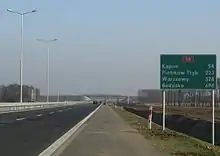
A few years before Poland entered the EU the tempo of motorway construction increased significantly. The main focus was on the east–west motorways A4 and A2. In 2002, a long-awaited renovation of the A4 from Krzywa to Wrocław (93 km) has started, which included laying new high quality surface in place of the Nazi German concrete slabs, reconstruction of all the pre-WWII bridges on the motorway and renovation of the viaducts above the motorway.
This is also a period when Poland started introducing motorway tolls, first in 2000 for the A4 section between Mysłowice and Kraków.
| Highway sections opened in 2000 – 2003 average: 57 km / year | |||||
|---|---|---|---|---|---|
| Signage | Section | Length | Start of construction | Opening | Notes |
| Poznań Komorniki - Poznań Krzesiny | 11.2 km (7.0 mi) | 1998 | 13 September 2003 | ||
| Poznań Krzesiny - Września | 37.3 km (23.2 mi) | 2002 | 27 November 2003 | ||
| Bielany Wrocławskie - Brzeg (Owczary) | 34.1 km (21.2 mi) | 1997 | 16 December 2000 | Southern carriageway reconstructed, northern carriageway constructed | |
| Brzeg (Owczary) - Dąbrówka Górna | 56.6 km (35.2 mi) | ||||
| Dąbrówka Górna - Nogowczyce | 34.3 km (21.3 mi) | 26 July 2001 | |||
| Nogowczyce - Kleszczów | 17.9 km (11.1 mi) | 2001 | 4 December 2003 | Southern carriageway reconstructed, northern carriageway constructed | |
| Chorzów - Katowice Mikołowska | 4.4 km (2.7 mi) | 1998 | 2001 | ||
| Kraków bypass (section ul.Kąpielowa - Wieliczka) | 7 km (4.3 mi) | 2000 | 3 September 2003 | ||
| Śmigiel bypass | 4.1 km (2.5 mi) | ? | 2002 | First carriageway | |
| Straszyn-Rusocin | 5.4 km (3.4 mi) | 2000 | 2001 | Second carriageway | |
| Białobrzegi bypass | 7.7 km (4.8 mi) | 2001 | 2003 | ||
| Ostrów Mazowiecka bypass | 7.6 km (4.7 mi) | 2000 | |||
| Total | 227.6 km (141.4 mi) of which 9.5 km (5.9 mi) single carriageway | ||||
Poland in European Union
1 May 2004 was a crucial day for the history of motorway construction, and that is when the highway boom started. One of major advantages of signing the European Union access document was that Poland could get access to large funds for co-financing the construction of new roads and upgrades of the existing road infrastructure.
These years, the existing pieces of the motorways started to converge into the basis of the future network: in 2005, A4 connected Wrocław with Katowice and Kraków, while in 2009 – with Germany; in 2006, A2 connected Poznań with Łódź. A large number of expressway bypasses of towns were also constructed at this time (on some of them only one carriageway was built with the allocated space prepared for adding a second one later).
| Highway sections opened in 2004 – 2009 average: 150 km / year | |||||
|---|---|---|---|---|---|
| Signage | Section | Length | Start of construction | Opening | Notes |
| Gdańsk (Rusocin) - Swarożyn | 24.2 km (15.0 mi) | 2005 | 2007 | ||
| Swarożyn - Grudziądz | 64.7 km (40.2 mi) | 2008 | |||
| Sośnica - Rybnik (Bełk) | 15.6 km (9.7 mi) | 22 January 2007 | 20 October 2009 | ||
| Nowy Tomyśl - Poznań Komorniki | 50.4 km (31.3 mi) | 2002 | October 2004 | ||
| Konin - Łódź (Stryków) | 103.7 km (64.4 mi) | 2004 | July 2006 | ||
| Krzywa - Bielany Wrocławskie | 93 km (57.8 mi) | 2002 | 2004–2006 (in sections) |
Renovated both carriageways | |
| Sośnica - Chorzów Batory | 15.7 km (9.8 mi) | 2002 | January 2005 | ||
| Kleszczów - Sośnica | 19.1 km (11.9 mi) | 2003 | October 2005 | ||
| Zgorzelec |
49.7 km (30.9 mi) | 2006 | August 2009 | ||
| Wieliczka - Targowisko | 19.5 km (12.1 mi) | 2007 | 2009 | ||
| Szczecin Klucz - Szczecin Kijewo | 7.7 km (4.8 mi) | 2005 | 2007 | Renovated both carriageways | |
| Olszyna |
71.5 km (44.4 mi) | 2004 | 2006 | Constructed the northern carriageway alongside the pre-WWII southern carriageway | |
| 10.0 km (6.2 mi) | 2002 - 2007 | 2004 - 2009 (in sections) |
Single carriageway; then signed S69 | ||
| Żywiec - Przybędza | 7.7 km (4.8 mi) | 2005 | 2007 | ||
| Pyrzowice airport - Podwarpie | 12.0 km (7.5 mi) | 2005 | 2006 | Single carriageway | |
| Gorzów Wielkopolski bypass | 11.9 km (7.4 mi) | 2003 | 2007 | Single carriageway | |
| Międzyrzecz bypass | 6.3 km (3.9 mi) | 2004 | 2006 | ||
| Nowa Sól bypass | 18 km (11.2 mi) | 2006 | 2008 | ||
| Szubin bypass | 4.5 km (2.8 mi) | 2004 | 2006 | Single carriageway | |
| Jędrzejów bypass | 5.8 km (3.6 mi) | 2003 | 2005 | Partially (2.7 km) single carriageway | |
| Nowy Dwór Gdański bypass | 2.5 km (1.6 mi) | 2005 | 2007 | ||
| Elbląg bypass | 4.2 km (2.6 mi) | 2005 | 2007 | ||
| Grójec bypass | 8.3 km (5.2 mi) | 18 October 2006 | 19 September 2008 | ||
| Białobrzegi - Jedlińsk | 15.7 km (9.8 mi) | 6 July 2006 | 30 June 2008 | ||
| Myślenice - Lubień | 16.2 km (10.1 mi) | 2004 | 2009 | ||
| Kielce bypass (northern part) | 7.1 km (4.4 mi) | 2007 | 2009 | ||
| Płońsk bypass | 4.7 km (2.9 mi) | 28 September 2007 | 3 June 2009 | ||
| Oleśnica bypass | 7.2 km (4.5 mi) | 2004 | 2006 | ||
| Wyszków bypass | 12.8 km (8.0 mi) | 27 February 2006 | 14 November 2008 | ||
| Wyszków - Radzymin | 17.3 km (10.7 mi) | 8 December 2006 | 31 July 2009 | ||
| Toruń bypass (fragment) | 12.4 km (7.7 mi) | 2004 | 2005 | Single carriageway; later incorporated into A1 | |
| Kobylanka bypass | 13.8 km (8.6 mi) | 2005 | 2007 | Partially (7 km) single carriageway | |
| Stargard bypass | 13.5 km (8.4 mi) | 2008 | 2009 | ||
| Bydgoszcz bypass (fragment) | 10.4 km (6.5 mi) | 2008 | 2009 | ||
| Wyrzysk bypass | 7.8 km (4.8 mi) | 2008 | 2009 | Single carriageway | |
| Poznań - Kórnik | 14.1 km (8.8 mi) | 2006 | 2009 | ||
| Ostrów Wlkp. bypass (northern part) | 6.1 km (3.8 mi) | 2008 | 2009 | Single carriageway | |
| Piaski bypass | 4 km (2.5 mi) | 2002 | 2004 | ||
| Puławy bypass | 12.7 km (7.9 mi) | 2005 | 2007 | Partially (8.7 km) single carriageway | |
| Garwolin bypass | 12.8 km (8.0 mi) | 2005 | 2007 | ||
| Międzyrzec Podlaski bypass | 6.3 km (3.9 mi) | 2005 | 2008 | Single carriageway | |
| Elbląg - |
51.6 km (32.1 mi) | April 2006 | December 2008 | Single carriageway. Constructed in place of a partially destroyed motorway from the 1930s. | |
| Cieszyn |
28 km (17.4 mi) | 2002 - 2005 | 2005 - 2007 (in sections) |
Then signed S1 | |
| Total | 900.5 km (559.5 mi) of which 244.5 km (151.9 mi) single carriageway, 100.7 km (62.6 mi) reconstructed | ||||
2010 – 2014
| Length of highways opened in 2010 – 2014 | ||
|---|---|---|
| Year | Length | Notes |
| 2010 | 135 km (84 mi) | |
| 2011 | 313 km (194 mi) | |
| 2012 | 639 km (397 mi) | Of which 195 km (121 mi) were opened before Euro 2012 championship |
| 2013 | 298 km (185 mi) | |
| 2014 | 279 km (173 mi) | |
| Total | 1,664 km (1,034 mi) | Of which 54 km (34 mi) first / second carriageway |
The sections opened in 2010 – 2014 belonged to the following highways:

 : + 356 km (221 mi) (S8 on the section Wrocław – Łódź was completed in 2014)
: + 356 km (221 mi) (S8 on the section Wrocław – Łódź was completed in 2014) : + 281 km (175 mi) (A1 on the section Gdańsk – Łódź was completed in 2014)
: + 281 km (175 mi) (A1 on the section Gdańsk – Łódź was completed in 2014)
 : + 234 km (145 mi) (A2 on the section Germany – Warsaw was completed in 2012)
: + 234 km (145 mi) (A2 on the section Germany – Warsaw was completed in 2012) : + 183 km (114 mi)
: + 183 km (114 mi) : + 170 km (106 mi) (S3 on the section Szczecin – A2 – Zielona Góra was completed in 2013, except that older single-carriageway parts remained so until 2017)
: + 170 km (106 mi) (S3 on the section Szczecin – A2 – Zielona Góra was completed in 2013, except that older single-carriageway parts remained so until 2017) : + 159 km (99 mi)
: + 159 km (99 mi)









 : + 281 km (175 mi) in total
: + 281 km (175 mi) in total
2015 – 2019
After the peak of investments before Euro 2012, very few new sections have been contracted in 2012 and 2013, which resulted in a small number of sections opened in 2015 and 2016, large share of which were the last delayed fragments originally contracted for a Euro 2012 opening. In particular:
- In 2016, the last delayed fragment of
 from Kraków to Ukraine was opened, making A4 the first major Polish highway completed on its whole intended length, as well as the first complete border-to-border highway connection.
from Kraków to Ukraine was opened, making A4 the first major Polish highway completed on its whole intended length, as well as the first complete border-to-border highway connection. - Also in 2016, the delayed bypass of Łódź was finished, making
 completed on its whole route except for those sections where national road 1 had already been a dual carriageway (see In the 1970s), allowing for a significantly lower priority of constructing the remaining stretch compared to other highways.
completed on its whole route except for those sections where national road 1 had already been a dual carriageway (see In the 1970s), allowing for a significantly lower priority of constructing the remaining stretch compared to other highways.
Since 2014, the number of signed contracts has risen again, resulting in the number of road openings having risen again since 2017.
| Length of highways opened in 2015 – 2019 | ||
|---|---|---|
| Year | Length | Notes |
| 2015 | 34 km (21 mi) | |
| 2016 | 123 km (76 mi) | |
| 2017 | 295 km (183 mi) | |
| 2018 | 318 km (198 mi) | |
| 2019 | 410 km (255 mi) | |
| Total | 1,180 km (733 mi) | Of which 83 km (52 mi) first / second carriageway |
The sections opened in 2015 – 2019 belonged to the following highways:
 : + 205 km (127 mi)
: + 205 km (127 mi) : + 194 km (121 mi) (S5 on the section Poznań – Wrocław was completed in 2019)
: + 194 km (121 mi) (S5 on the section Poznań – Wrocław was completed in 2019) : + 166 km (103 mi)
: + 166 km (103 mi) : + 144 km (89 mi) (S8 was completed on its originally intended route from Wrocław to Białystok in 2019; an extension to Kłodzko was later added to the plans)
: + 144 km (89 mi) (S8 was completed on its originally intended route from Wrocław to Białystok in 2019; an extension to Kłodzko was later added to the plans) : + 128 km (80 mi) (S6 on the section Szczecin – Koszalin was completed in 2019)
: + 128 km (80 mi) (S6 on the section Szczecin – Koszalin was completed in 2019)







 : + 343 km (213 mi) in total (A1 and A4: see above)
: + 343 km (213 mi) in total (A1 and A4: see above)
2020 – present
| Length of highways opened, or to be opened, in 2020 – 2024 by the contract completion date | ||
|---|---|---|
| Year | Length | Notes |
| 2020 | 137 km (85 mi) | |
| 2021 | 504 km (313 mi) | Ongoing constructions |
| 2022 | 259 km (161 mi) | Ongoing constructions[32][33] |
| 2023 | 278 km (173 mi) | Ongoing constructions, ongoing design-build contracts[32][33] |
| 2024 | 367 km (228 mi) | Ongoing design-build contracts, ongoing tenders with completion of the contracted works planned for 2024 (figure might change)[33] |
| Total | 1,545 km (960 mi) | Of which 7 km (4 mi) first carriageway, 125 km (78 mi) second carriageway |
The sections opened, or planned to get opened, in 2020 – 2024 belong to the following highways:
 : + 287 km (178 mi) (S19 "Via Carpathia" on the section Lublin – Rzeszów is scheduled to get completed in 2022)
: + 287 km (178 mi) (S19 "Via Carpathia" on the section Lublin – Rzeszów is scheduled to get completed in 2022) : + 187 km (116 mi) (S61 "Via Baltica" is scheduled to get completed in 2023)
: + 187 km (116 mi) (S61 "Via Baltica" is scheduled to get completed in 2023) : + 177 km (110 mi) (S7 on the section Warsaw – Kraków is planned to get completed in 2024)
: + 177 km (110 mi) (S7 on the section Warsaw – Kraków is planned to get completed in 2024)
 : + 135 km (84 mi)
: + 135 km (84 mi) : + 121 km (75 mi) (S3 is scheduled to get completed in 2024)
: + 121 km (75 mi) (S3 is scheduled to get completed in 2024) : + 94 km (58 mi) (S5 on the section Grudziądz (A1) – Poznań is scheduled to get completed in 2022)
: + 94 km (58 mi) (S5 on the section Grudziądz (A1) – Poznań is scheduled to get completed in 2022) ,
,  ,
,  ,
,  ,
,  : + ca. 70 - 80 km each (A1 is scheduled to get completed in 2022; reconstruction of the second carriageway of A18 is scheduled to get completed in 2023; S1 is planned to get completed in 2024)
: + ca. 70 - 80 km each (A1 is scheduled to get completed in 2022; reconstruction of the second carriageway of A18 is scheduled to get completed in 2023; S1 is planned to get completed in 2024)




 : + 130 km (81 mi) in total (S17 on the section Warsaw – Lublin is scheduled to get completed in 2020)
: + 130 km (81 mi) in total (S17 on the section Warsaw – Lublin is scheduled to get completed in 2020)
Total length of motorways and expressways in Poland (end of the year)
| Year | Highways, total length |
|---|---|
| 1936 (then Nazi Germany) | 92 km |
| 1937 (then Nazi Germany) | 104 km and 38 km first carriageway |
| 1938–1945 (then Nazi Germany) | 133 km and 135 km first carriageway (further below not considered as a motorway until addition of the second carriageway) |
| 1939–1945 (Poland) | 28 km (today not considered as a highway) |
| 1945–1976 | 133 km |
| 1977 | 169 km |
| 1978 | 169 km |
| 1979 | 190 km |
| 1980 | 190 km |
| 1981 | 190 km |
| 1982 | 190 km |
| 1983 | 255 km |
| 1984 | 278 km |
| 1985 | 321 km |
| 1986 | 327 km |
| 1987 | 327 km |
| 1988 | 348 km |
| 1989 | 366 km |
| 1990 | 381 km |
| 1991 | 399 km |
| 1992 | 399 km |
| 1993 | 403 km |
| 1994 | 405 km |
| 1995 | 440 km |
| 1996 | 453 km |
| 1997 | 456 km |
| 1998 | 490 km |
| 1999 | 502 km |
| 2000 | 592 km |
| 2001 | 630 km |
| 2002 | 639 km |
| 2003 | 727 km |
| 2004 | 781 km |
| 2005 | 848 km |
| 2006 | 1013 km |
| 2007 | 1083 km |
| 2008 | 1282 km |
| 2009 | 1454 km |
| 2010 | 1560 km |
| 2011 | 1865 km |
| 2012 | 2495 km |
| 2013 | 2805 km |
| 2014 | 3100 km |
| 2015 | 3131 km |
| 2016 | 3252 km |
| 2017 | 3510 km |
| 2018 | 3811 km |
| 2019 | 4214 km |
| 2020 | 4376 km (forecast[32][33]) |
| 2021 | 4893 km (forecast[32][33]) |
| 2022 | 5104 km (forecast[32][33]) |
| 2023 | 5354 km (plans[34][33]) |
| 2024 | 5862 km (plans[34][33]) |
| 2025 | 6305 km (plans[34][33][35]) |
| 2026 | 6532 km (plans[34][36][37]) |
| 20?? | 8000 km (year unknown; according to plans) |
See also
References
- "Autostrady :: Generalna Dyrekcja Dróg Krajowych i Autostrad - Strona Główna". www.gddkia.gov.pl.
- Including joint design–build contracts. Of these 791 km (492 mi) in active construction.
- "S3 Miękowo - Rzęśnica :: Generalna Dyrekcja Dróg Krajowych i Autostrad - Serwis informacyjny". www.gddkia.gov.pl.
- "Aktualności – S3 Miękowo – Rzęśnica".
- https://www.gddkia.gov.pl/pl/a/37957/Przed-dlugim-weekendem-uruchamiamy-dwie-jezdnie-na-S3-i-A6-od-Szczecina-do-Goleniow
- "Ustawa z dnia 21 marca 1985 r. o drogach publicznych". prawo.sejm.gov.pl.
- "Obwieszczenie Ministra Infrastruktury i Budownictwa z dnia 23 grudnia 2015 r. w sprawie ogłoszenia jednolitego tekstu rozporządzenia Ministra Transportu i Gospodarki Morskiej w sprawie warunków technicznych, jakim powinny odpowiadać drogi publiczne i ich usytuowanie". prawo.sejm.gov.pl.
- "Umowa na analizę dla rozbudowy A4 Wrocław – Krzyżowa podpisana! :: Generalna Dyrekcja Dróg Krajowych i Autostrad - Serwis informacyjny". www.gddkia.gov.pl.
- "A6 Węzeł Szczecin Kijewo – A6 Węzeł Szczecin Kijewo".
- "A6 Szczecin Dąbie - Rzęśnica :: Generalna Dyrekcja Dróg Krajowych i Autostrad - Serwis informacyjny". www.gddkia.gov.pl.
- >https://www.money.pl/gospodarka/wiadomosci/artykul/a18-droga-hanby-patatajka,247,0,2413047.html
- "Rozporządzenie Rady Ministrów z dnia 15 maja 2004 r. w sprawie sieci autostrad i dróg ekspresowych". prawo.sejm.gov.pl.
- "Rozporządzenie Rady Ministrów z dnia 20 października 2009 r. zmieniające rozporządzenie w sprawie sieci autostrad i dróg ekspresowych". prawo.sejm.gov.pl.
- "Dziennik Ustaw 2019 r. poz. 1819". www.dziennikustaw.gov.pl.
- "Zmiany w rozporządzeniu w sprawie sieci autostrad i dróg ekspresowych - Ministerstwo Infrastruktury i Budownictwa". mib.gov.pl. Retrieved 2016-07-05.
- http://prawo.sejm.gov.pl/isap.nsf/DocDetails.xsp?id=WDU20180000741: Appendix 2, footnote 1 (in Polish)
- https://www.gddkia.gov.pl/userfiles/articles/g/generalny-pomiar-ruchu-w-2015_15598//SYNTEZA/WYNIKI_GPR2015_DK.pdf
- "Zestawienie realizacji autostrad i dróg ekspresowych w Polsce". Retrieved 2019-12-26.
- "Progress of road construction preparation works :: Generalna Dyrekcja Dróg Krajowych i Autostrad". www.gddkia.gov.pl/pl/. Retrieved 2020-11-17.
- "Mapa budowy dróg ekspresowych i autostrad". Retrieved 2019-12-26.
- "Map of construction of Polish highways - SISKOM & SSC". ssc.siskom.waw.pl. Retrieved 2019-12-26.
- "Amendment to Road Construction Plan of 16 June 2020 - Ministry of Infrastructure". gov.pl.
- ""Rozwój sieci dróg szybkiego ruchu"". www.gddkia.gov.pl.
- https://www.gddkia.gov.pl/userfiles/articles/g/GENERALNY_POMIAR_RUCHU_2000/0.1.3.3_Raport_GPR_2000.pdf
- https://www.gddkia.gov.pl/userfiles/articles/g/generalny-pomiar-ruchu-w-2015_15598//SYNTEZA/Synteza_GPR2015.pdf
- https://www.gddkia.gov.pl/userfiles/articles/g/generalny-pomiar-ruchu-w-2015_15598//SYNTEZA/WYNIKI_GPR2015_DK.pdf
- "Warszawa. Coraz większy ruch przez Wisłę. Most Grota pęka w szwach". www.rynekinfrastruktury.pl.
- Labelled S69 in the source
- "GPR 2020 :: Generalna Dyrekcja Dróg Krajowych i Autostrad - Serwis informacyjny". www.gddkia.gov.pl.
- https://www.gddkia.gov.pl/pl/a/36989/Przesuniety-pomiar-GPR2020M
- Prof. M. W. Nestorowicz, Problem budowy dróg samochodowych (autostrad) w Polsce
- "List of ongoing road contracts signed by GDDKiA".
- https://www.gddkia.gov.pl/frontend/web/userfiles/articles/p/program-budowy-drog-krajowych-sp_35147/Standia_20.12.2019.pdf
- https://www.gov.pl/attachment/f02f198f-abb1-4e93-b8e9-3d7c4a555577
- "S6 Obwodnica Metropolii Trójmiejskiej". www.ppp.gov.pl.
- "S10 Bydgoszcz - Toruń". www.ppp.gov.pl.
- "S6 Zachodnia obwodnica Szczecina". www.ppp.gov.pl.
External links
| Wikimedia Commons has media related to Highways in Poland. |
- General Directorate for National Roads and Motorways (in Polish, some information also in English)
